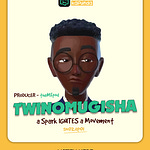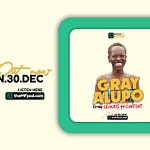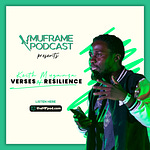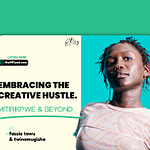How a quantity surveyor's precision met a carpenter's soul to build something extraordinary.
Prologue: The Geometry of Failure
In the sterile corridors of Makerere University's architecture department, Charles Ronald Iragaba confronted a truth that would reshape his entire trajectory: sometimes our greatest failures are the most precise instruments of our becoming. The portfolio course that defeated him wasn't just an academic stumble, it was the first crack in a foundation that needed to crumble before something more authentic could rise.
This is not another entrepreneur's origin story. This is a meditation on the mathematics of reinvention, where precision meets passion, and where the tools of one trade become the unexpected foundation for mastery in another.
The Surveyor's Eye, The Maker's Heart
The Precision of Purpose
Charles's journey from architecture to quantity surveying wasn't retreat. It was reconnaissance. In the world of QS, he learned the language of materials, the grammar of costs, and the syntax of project management. These weren't just professional skills; they were the building blocks of a different kind of architecture, one that would later manifest in wood grain and joinery.
The irony wasn't lost on him: while studying to quantify other people's creations, he was unconsciously mapping the territory of his own creative rebellion. Every cost estimate, every material specification, every timeline calculation was preparing him for a future he couldn't yet envision.
The Lockdown Laboratory
When COVID-19 suspended the world in March 2020, Charles found himself in an unexpected laboratory of possibility. The postponed exams weren't just a delay, they were a pause that became a portal. In the enforced stillness, he asked himself a question that would echo through everything that followed: "What can I do today that matters tomorrow?"
The answer came not in a flash of inspiration, but in the disciplined accumulation of small actions. He began writing on LinkedIn not about his weekend or his lunch, but about the intersection of construction, design, and possibility. Each post was a small act of faith, a signal sent into the digital void that said: I have something to offer.
3,300 followers. Not massive by today's standards, but each one represented a person who had chosen to pay attention to his thoughts. When a friend challenged him to monetize that attention, Charles faced a moment of profound choice: Would he treat this audience as a resource to be extracted from, or as a community to be served?
The Carpenter's Paradox
Beyond the Brokerage Dream
The initial idea was clean, digital, scalable, a brokerage app connecting architects, quantity surveyors, and designers. It had all the hallmarks of contemporary entrepreneurship: low overhead, high margins, network effects. But Charles possessed something more valuable than a good business idea: he had integrity.
The pivot to furniture wasn't strategic in the traditional sense. It was gravitational, a natural pull toward work that engaged his hands as much as his mind. In choosing carpentry, he chose the harder path: physical materials, skilled labor, quality control, customer education. He chose substance over scale.
The Alchemy of Skills
What emerged was something unprecedented in Uganda's carpentry landscape: a furniture maker who could read architectural drawings, calculate material costs to the shilling, and manage projects with the precision of a construction professional. Charles didn't just change careers, he created a new category.
His mother's loan wasn't just seed capital; it was a vote of confidence from the person who knew him best. The client's 50% prepayment wasn't just cash flow it was validation that the market was ready for what he was offering. By summer 2020, Details Africa had moved from concept to commission, from idea to income.
The Laboratory of Trust
Curating Craftsmen
In an industry where "anyone with a saw calls themselves a carpenter," Charles faced his first real test of leadership. How do you build a team when the talent pool is polluted with what he diplomatically calls "jokers" people who mistake enthusiasm for expertise?
The answer lay in his quantity surveyor's training: rigorous evaluation, clear standards, and systematic quality control. He didn't just hire carpenters; he curated craftsmen. The result is a core team of five skilled artisans backed by three trusted subcontractors a small army of makers who share his commitment to excellence.
The Trust Economy
Uganda's carpentry market presents a fascinating paradox: it's simultaneously mature and virgin. Mature in that furniture-making is an ancient craft with established players. Virgin in that reliability and transparency remain rare commodities. Charles saw this not as a problem to complain about, but as an opportunity to differentiate.
His approach to trust-building is architectural in its systematicity:
Foundation Layer: Source well-seasoned local timber, never cutting corners on materials Framework Layer: Execute precise joinery with attention to detail that borders on obsession
Finishing Layer: Maintain transparent communication, especially when problems arise Maintenance Layer: Leverage social media to showcase process, not just product
Each project becomes a case study in how business should be conducted. Each satisfied client becomes a walking advertisement for a new standard of professionalism.
The Economics of Meaning
Beyond Profit Maximization
Charles operates from a fundamentally different economic philosophy than most entrepreneurs. For him, profit is not the point. It's a byproduct of doing meaningful work well. This isn't naive idealism; it's sophisticated capitalism that recognizes the long-term value of stakeholder alignment.
His approach to employee relations reads like a case study in enlightened management:
Equity sharing: Making key craftspeople company directors with ownership stakes
Fair wages: Paying above market rates to attract and retain top talent
Shared ownership: Creating a culture where everyone benefits from collective success
Skills development: Investing in continuous learning and professional growth
The Regenerative Model
Details Africa's environmental philosophy reflects Charles's QS training: everything must be measured, planned, and accounted for. The commitment to plant replacement trees isn't just environmental theater. It's a systematic approach to resource stewardship that ensures the business can operate sustainably for decades.
The planned training school represents the logical extension of this philosophy: if you're going to extract value from an industry, you have an obligation to invest in its future. By training the next generation of carpenters, Charles is building not just a business, but an ecosystem.
The Pedagogy of Craft
Teaching Through Making
The vision for a carpentry training school isn't just about skills transfer. It's about cultural transformation. Charles has observed that technical competence without business ethics creates skilled incompetence. His curriculum will address both dimensions: how to cut a perfect joint and how to build a trustworthy enterprise.
The community workshops teaching basic home repairs represent something even more profound: the democratization of making. In a culture increasingly dependent on specialists, Charles wants to return fundamental skills to ordinary people. It's a small revolution disguised as a community service.
The Ripple Architecture
Charles's long-term vision reveals the true sophistication of his thinking. Health insurance for all employees, performance-based year-end bonuses, and profit-sharing partnerships aren't just benefits—they're investments in human capital that compound over time.
When employees own equity, they think like owners. When craftspeople share in success, they invest in excellence. When community members learn basic skills, they become more self-reliant and more appreciative of advanced craftsmanship.
The Creative Survival Manual
Lessons from the Workshop Floor
Charles's journey offers a masterclass in creative entrepreneurship that transcends carpentry:
The Pivot Principle: Sometimes your dream role comes on the other side of apparent failure. The architecture portfolio course that defeated him became the catalyst for finding his true calling.
The Capital Equation: In a knowledge economy, your skills are your most valuable asset. Charles leveraged his QS training to create competitive advantages that pure carpenters couldn't match.
The Foundation Fundamentals: Creative work without business discipline is expensive self-expression. Costing, project management, and clear communication are the unsexy skills that enable creative freedom.
The Transparency Dividend: Trust is the ultimate competitive advantage. Under-promise and over-deliver, especially when problems arise.
The Stakeholder Strategy: Shared ownership creates shared commitment. When success is collective, excellence becomes inevitable.
The Portfolio Course Question
Charles's story poses a profound question for every creative professional: What "portfolio course" have you failed at or resisted that might actually be your personal gateway to a new creative path?
The failures that sting most often contain the seeds of our greatest breakthroughs. The skills that feel irrelevant often become the foundation for innovation. The paths that appear to be detours often lead to destinations we never could have imagined.
Epilogue: The Unfinished Project
Details Africa is not a completed work—it's a living project that continues to evolve. Charles's vision of a carpentry training school, a reforestation program, and a community of skilled makers represents something larger than a business plan. It's a blueprint for how creative entrepreneurs can build enterprises that serve not just their own ambitions, but the broader community's needs.
In the end, Charles Ronald Iragaba's story is not just about furniture—it's about the architecture of a life well-lived. It's about the courage to pivot when the path isn't right, the wisdom to build on your strengths, and the vision to create something that matters beyond the bottom line.
The sawdust will settle, the projects will be completed, and the customers will move on. But the example Charles is setting of professionalism, integrity, and social responsibility will echo through Uganda's creative economy for generations to come.
This is how you build a legacy: one perfectly crafted joint at a time.
Listen to the full conversation with Charles Ronald Iragaba on The MuFrame Podcast, where we explore the intersection of craft, commerce, and community in Uganda's creative economy.











